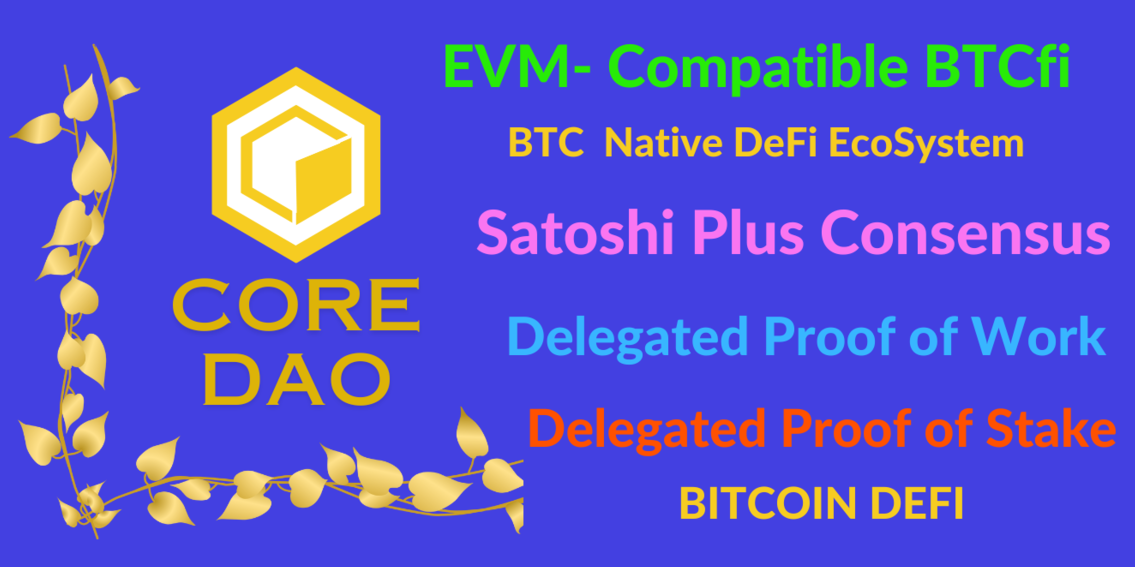Core Chain Network Explained : Core Dao Tokenomics
Introduction : Core Chain Mechanism
The Core network Blockchain, also known as Core Chain, is a layer one blockchain that is compatible with EVMs and powered by bitcoin.
- The primary innovation of Core Network Chain is Satoshi Plus, a novel consensus mechanism that integrates Delegated Proof of Work (DPoW) and Delegated Proof of Stake (DPoS).
Security : Core Chain’s Approach to Security
Core Chain mitigates network attacks by combining geographic dispersion of nodes, and randomizing the choice of P2P nodes.
- All of these are validator-level security measures that are used in numerous blockchain projects.
- In the case of consensus attacks In the case of consensus attacks, the combo of DPoW, DPoS, and the mechanism for validator elections offer numerous desirable security features.
For instance the selfish mining technique has been eliminated by Core Chain’s round-robin mining method.
- This technique prevents manipulation of pseudorandom mechanisms these exploits usually rely on.
- Transaction delays and censorship could be a threat vector that are largely mitigated as long as there are validators who are honest within the group.
- Similar to this 51% attacks Sybil attacks, as well as similar vulnerabilities aren’t completely preventable however, attempting one of these is economically inadvisable and difficult to achieve due to the fact that validators are ranked based on their score in a hybrid.
- One of the most important aspects in stopping long-range security breaches is together Core Chain’s Check pointing system that keeps the blockchain’s history indefinitely frozen regularly and adds a checkpoint hash of the base code and then rejects any subsequent transactions that aren’t in line with the hashes.
- There are many types of malicious attacks that involve returning to a specific date and time, then mining a chain of rivals which reverses transactions, block access to networks, etc.
- When combined with DPoW checking point, it renders us unaffected by this swarm of dangers.
CORE Token : Tokenomics
CORE is the token of governance and utility of the Core network. Its capabilities include, but aren’t only limited to.
- Payment for gas or transaction.
- The Core network is being staked.
- Participating in the Core network on-chain Governance.

Sound Supply :
Like Bitcoin, CORE’s supply comes with an upper limit that is 2.1 billion coins. To top off this hard limit, an portion of all block rewards as well as transactions fees are disposed of in a way like the Ethereum’s “Ultra Sound Money“.
- The exact percentage of the burned amount can be assessed from the DAO.
- In essence the total quantity of CORE tokens will be close to but not surpass the hard limit that is 2.1 billion.
CORE Emissions :
The CORE block reward tokens will be paid over an 81-year time frame.
- This lengthier period improves the chances of success effectively motivating everyone on the network before the network finally transitions to only compensation transaction fees.
- The CORE block rewards can be considered an opportunity to allow Bitcoin miners to earn an additional income.
- It’s widely known that Bitcoin block reward program will end completely around 2140, at when a mix of transaction costs and cash payouts from other networks such as Core Chain will benefit incentivize miners to keep up their work.
- However, the ratchet-like nature of Bitcoin’s monetary policies – specifically its halvings – could require such payments prior to 2140.
- Through becoming validators on Core network, and handing over their hash power Bitcoin miners will be able to earn via both Bitcoin transactions as well as Core tokens rewards.
Governance : Core DAO
Core DAO serves as the group responsible for overseeing Core DAO’s oversight of the Core network.
- Its responsibilities include (but aren’t limited to) increasing an array of validation agents, setting the governance of the network, and determining the amount of block rewards and transaction fees burned.
Progressive Decentralization
Core’s decentralization does not limit itself at the level of consensus as time goes on, the management of the whole Core network will be gradually decentralized.
- As the network matures and grows, Core DAO will increasingly incorporate broader participation from the community, culminating in entire CORE token holders being involved in governance functions and administration of CORE Treasury.
Objectives
In the beginning in this endeavor, main objectives of the maintenance of the network are easy:
- Give a gradual route to decentralization
- Reduce risk to DAOs which are formed on the top of the Core Chain;
Decentralization Phases
The general goal is to gradually decentralize management functions by completing three phases of development:
- In the present, Core Chain operates preponderantly through off-chain governance, which
- Resolutions will be adopted after a majority of DAO voting members agree
- The next phase will be the one that is limited in on-chain governance:
- A set of predetermined parameters, such as the percent of the burned fee can be altered through onchain voting.
- The addition and subtraction of parameters will be at sole discretion of DAO electors, as reflected in core improvement Proposals (CIP);
- There could be time-delays to discourage the buying of votes and other similar attacks.
- The last stage will be the full on-chain governance, which includes:
- The community will be completely in control and lead the community into the future.

Core Chain : Related Works
Core Chain is an revolutionary L1 which combines the elements of various other L1s. It is important to understand the concept behind it and how it operates consequently, is likely to be much easier following an explanation of other similar blockchain-related projects.
Bitcoin :
Bitcoin in 2009 Satoshi Nakamoto cut digital scarcity out of an abundance stone for the first time.
- Bitcoin’s hard limit at 21 million coins continues be a source of inspiration for the token mechanics used in blockchain projects nearly 15 years later. the present, Bitcoin is known as the most secure and centralized cryptocurrency currently in use.
- The most important factor in Bitcoin’s success is the “miners”, who are responsible for validating any new transactions and logging them onto the blockchain.
- This is done through Proof of Work, a rigorous process that helps maintain the integrity of the network as well as decentralization through making fraud, theft and direct attacks extremely costly.
- While this method has proven to be robust, given Bitcoin’s limited throughput (a mere seven transactions every minute) and the limitations of its software language can’t scale sufficient to accommodate a large system of smart contracts.
Ethereum (Pre-Merge) :
Prior to “the merge,” Ethereum was also the PoW system of consensus, as well as being protected by a mining system that was similar to (but far from being as decentralized) Bitcoin’s.
- Ethereum introduced a robust feature set, which included the Turing-complete Ethereum Virtual Machine (EVM) capable of running smart contracts.
- This feature made Ethereum apart, and helped to create an expansive community of decentralized applications (dApps) and also spawning new sectors such as decentralized finance (DeFi).
- However, it was stripped of Bitcoin’s security and decentralization while being constrained due to the PoW mechanism in regards to scaling.
Ethereum (Post-Merge) :
Presently, Ethereum operates on Proof of Stake.
Validators are the ones who propose and verify the authenticity to the validity of block transactions on Ethereum blockchain.
- They are chosen randomly according to how much Ether they’re willing to “stake” as collateral.
- From the beginning, Ethereum was designed to move into Proof of Stake, but this transition has raised questions about decentralization as well as future scalability.
- In the future, the concentration in the number of coins, and thus control over the network, is expected particularly as a small number of custodians and staking pool owners increase their share of managing tokens and staking reward.
Solana :
Solana is a chain with high-throughput with a capacity of 50k TPS.
- It utilizes simultaneously Proof of History (PoH) and Sharding Yakand sharding [Yak].
- Solana is extremely fast in block times, which are as low as 400ms for each block (Tead) which enables applications developed on the network to appear as if they are Web2 counterparts.
- To bring off this quality of performance the requirements for running an authenticator are far more than the requirements for other networks [Teae.
This puts smaller players out of the market, which limits the degree of decentralization Solana is able to fulfilL.
- A different trade-off is between network performance and availability.
- This was evident by several recent notable Chain restarts (McS)Mil.
- Solana is also home to one of the most active communities of developers However, the change to Solidity to Rust has been a challenge for a lot of people.
Polygon:
Polygon is an L2 scaling solution based on PoS built on the top of Ethereum.
- Its primary goal is to address many of the problems with scaling in the primary Ethereum chain through the use of PoS and other side chains (Teac).
- Polygon has drawn a large number of developers due to its EVM compatibility, which permits developers of dApps to transfer their code with only minor modifications (Teab).
- It is also a great way to integrate with other blockchains.
BNB Smart Chain : (BSC)
BSC is an unofficial fork of the Go Ethereum (Geth) codebase.
- One of the main differences among BSC as well as Ethereum is the one that is called Proof of Staked Authority (PoSA).
- Which is a consensus mechanism which combines Proof of Authority (PoA) and Delegated Proof of Stake (DPoS) [Teaa].
- The new mechanism for consensus permits BSC to fulfill quicker transaction times along with higher TPS as well as lower charges [CZ].
- Similar to Polygon there has been a lot of concerns about Centralization in BSC’s validator set.
- A variety of factors have contributed to this situation such as the high stake prerequisites to be validators as well as the reality that only two validators out of the twenty-one are participating in consensus tasks at the same time [Tra], and speculation about the close relationship between Validators as well as Binance.
- The idea that Binance owns one of the nodes however, is not supported by with data from onchain data BSC.

Core Objectives and Principles :
- Core Chain operates as a secure, decentralized and scalable blockchain system that is backed with Bitcoin’s PoW.
- This article will discuss the (and other) essential features associated with the Core network, and then describes how each one is managed.
Bitcoin-aligned :
- Core Chain was created to (a) increase Bitcoin’s security by allowing Bitcoin miners to transfer their security to an EVM-compatible smart contract platform, and (b) provide a subsidy to Bitcoin mining by offering CORE tokens as rewards to Bitcoin miners, which require no extra expense or cost.
- While Bitcoin acts as a defender of a scarce and inactive monetary asset Core Chain is designed to be the uncentralized rails on that digital currencies obtain considerable value.
Decentralized :
Core Chain’s decentralization is made possible by a two-part mechanism which validators are chosen in accordance with Satoshi Plus consensus.
- On one hand, Bitcoin miners can elect validators by writing their data into the transactions on coinbase of newly mined Bitcoin blocks (DPoW).
- On the other hand, CORE token holders are able to vote for validators through assigning CORE tokens for them (DPoS).
- Since Bitcoin is hashing power, and the CORE tokens distributed they both DPoW and DPoS aspects of the Satoshi Plus consensus work together to ensure the decentralization of Core Chain.
Secure :
Core Chain’s security relies on a variety of foundations.
- The first is decentralization described above, which is accomplished through the combination between DPoW in conjunction with DPoS.
- Another is the security system used by Core Chain.
- The Core Chain network is able to thwart the attacks of consensus through its incentive structures that provide rewards to participants who detect malicious nodes, as well as methods to punish the nodes.
- Additionally, it includes checks pointing and other security features to prevent other types attack that are long range.
- You can find a more in-depth description of security here and includes audits from a variety of leading blockchain security companies.
Scalable :
- Core Chain is extremely scalable, capable of eventually sustaining a global user number of billions of users and has a high rate of transaction speed with low latency.
- This is due because DPoS is more adaptable than PoW or standard PoS or PoW and also due because the network has the ability to improve the speed of mining blocks by introducing more validators.
- Additionally, there will be more scaling strategies developed in conjunction with this network over the near future.
Permission-less :
- Core Chain’s permission lessness allows everyone can join and develop on Core Chain, without approval or authorization from any gatekeeping institution.
- Core Chain’s decentralization, open source software and consensus-based model were designed in order to preserve this freedom for the foreseeable future.
Community-Governed :
Core Chain’s governance consists of mutable and immutable elements.
- The immutable components are the ones that need to remain in place as well as the entire amount of CORE.
- However, other aspects of the on-chain governance could benefit from a more flexible system.
- In these cases organizations, the decentralized autonomous entity that is responsible for the development of networks, Core DAO, is created to become more decentralized as participation on the blockchain increases.
- The holders of all CORE tokens are able to decide on the changes made to specific protocol parameters, but are bound by the immutable nature of Core Chain’s design. which will be explained in greater detail in the future.
Interoperable :
- Core Chain is interoperable with HTML0. Core Chain can interface with many different blockchain-related projects.
- Because it’s EVM compatible, all protocols that run that are on Core Chain can interact with each other.
- Ethereum-based protocols are able to be ported onto Core Chain with relative ease and cross-chain solutions enable the exchange of data between different blockchains.
Composable :
Core Chain, composability can be accomplished through the support of the well-known Solidity smart contracting language.
- Solidity lets developers create smart contracts that are able to invoke functions in other contracts, and send CORE tokens back to them, or even generate new instances of contracts.
- This permits the development of intricate interlocking systems of contracts that can facilitate peer-to-peer lending and borrowing, open trading platforms, liquidity pools with live, precise data on-chain, and more.
Conclusion :
The Core blockchain, a decentralized network with a novel Satoshi Plus consensus mechanism that combines Delegated Proof of Work and Delegated Proof of Stake, is described in the paper.
- By expanding Bitcoin mining security to an alternative protocol, and offering miners free supplementary reward, Core Chain integrates Bitcoin’s incentive alignment into a flexible intelligent contracting platform.
- This outcome in improvements to scaling, security, efficiency and decentralization, together and EVM-compatibility, let you enjoy the potential of Bitcoin-secured decentralized apps for users, developers, and others.








